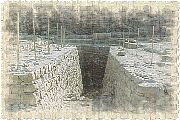|
The
buildings on the west side of the court have been partially
restored. These buildings are nothing more than limestone
walls filled up with rubble. They were probably made to resemble
existing shrines made of wood and mudbrick. As was the case
of the entrance, here too doors and fences have been rendered
in stone.
It
is interesting to note that all the features that would make
Egyptian architecture so distinct are already present in this
complex in general, and in the "Heb Sed" court in particular.
The best example is the southernmost chapel that already has
some rounded elements at its corners and a roof that bends
outwards slightly.
The rounded elements at the corners are stone imitations of
the wooden poles that were used in constructing small buildings.
The roof that bends outwards, an architectural feature that
would be used for the next 3,000 years, is a stone copy of
bushes of reeds that were (and in some places still are) often
placed on walls and at roof level.
Leaving
the "Heb Sed" court through the passage in the north, the
visitor passes the east side of the pyramid, which lies to
the left. To the right are located two more dummy buildings:
the houses of the south and north, probably representing Upper
and Lower Egypt respectively.
|
 |
In
the entrance of the "House of the South", a hieratic text was
scribbled on the wall during the eighteenth dynasty, more than
a thousand years after the complex was built. A small building
built against the eastern part of the north face of the pyramid
) contains a copy of a statue of Djoser. The original statue
can now be seen at the Cairo museum. When it still stood at
its original location it was able to "look" outside through
a small hole in the wall. This kind of structure, containing
a statue of the deceased, is known as "serdab". It was a common
feature of funerary complexes of the late Early Dynastic Period
and the Old Kingdom.
Next
to the "serdab", more to the middle of the north face of the
pyramid, is located the actual mortuary temple. As this was
the part of the complex where priests would come to present
the deceased Djoser’s funerary offerings, is not surprising
that it is not a dummy building. It is sometimes assumed that
the mortuary temple belongs to the last building stages of
the complex, and in that case it may even have been built
after Djoser’s death.
|
 |
It
is here that the entrance to the subterranean rooms and the
actual burial chamber of the king can be found.
 |

Entrance to the Step Pyramid |
 |
Seen
from the point of view of the deceased, the entrance is oriented
towards the north.
This
feature (which can be traced back to the end of the first
dynasty), was the result of the belief that the deceased king
would take his place among the circumpolar stars - the stars
that were visible throughout the year and that were therefore
considered to be indestructible and eternal.
The
area to the north of the mortuary temple has not yet been
thoroughly examined. The purpose of this area is therefore
unclear. Underneath it, there are some subterranean galleries
and rooms that may have been storage rooms for Djoser’s daily
funerary cult. Some of the subterranean spaces however may
also have been royal tombs of the 2nd dynasty that were incorporated
into the complex.
In
the middle of the northern part of the enclosure wall, there
is a stone structure made to resemble the hieroglyph representing
an altar. The purpose of this altar is not clear. The fact
that it is located in the north may perhaps relate it to a
cult of the circumpolar stars, or in other words of the deceased
kings. More research would be required to fully understand
this part of the complex.
(Jacques
Kinnaer)
|